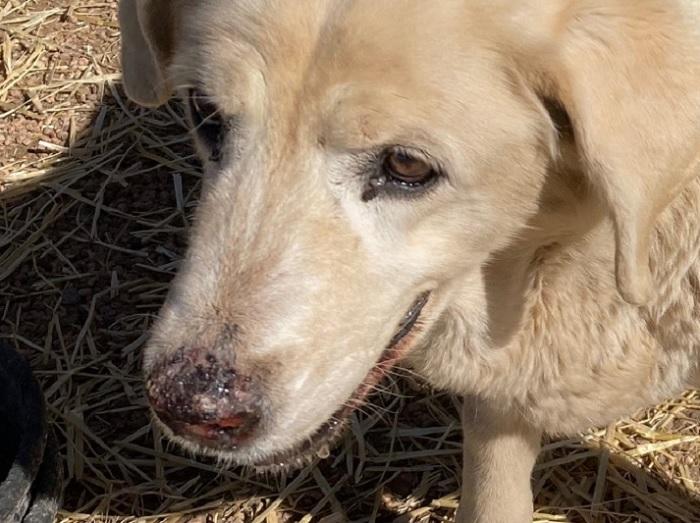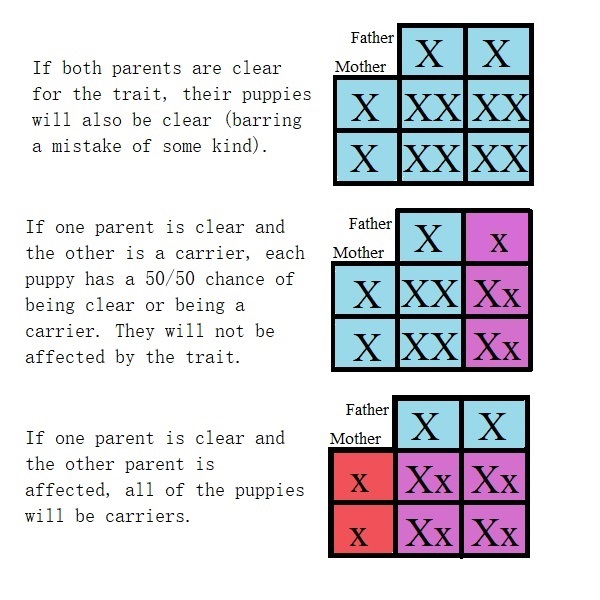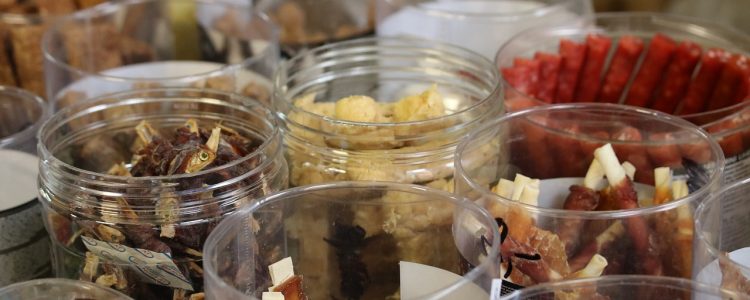Centronuclear Myopathy (CNM) is an inherited congenital disorder that causes muscle dysfunction.
About CNM
In a nutshell, CNM in Labradors causes muscle wasting which makes moving normally difficult. Some dogs have severe symptoms while other dogs are only mildly affected.
In the past, it’s been called generalized muscle weakness, polyneuropathy, muscular myopathy, muscular dystrophy, hereditary myopathy.
Breeds affected are Labrador Retrievers, plus doodles and other Lab mixes.
Here is a video of a Labrador suffering from acute CNM.
To develop a genetic test, researchers collected samples from 7,426 Labradors living in 18 countries. They found 80 dogs from various countries had two copies of the mutated gene. These dogs all showed muscle wasting symptoms. Of the 1,172 dogs that had one copy of the mutated gene, none showed symptoms which showed that CNM in Labradors is caused by a simple recessive gene.
Dogs with two normal genes are normal. Dogs with one normal gene appear normal, but could pass the mutated gene to their puppies. Dogs with two mutated gene are affected and will develop muscle wasting.
Currently researchers believe the mutated gene is the result of a single mutation. Also that the gene spread rapidly through the Labrador population because many people bred to a small group of popular sires about 60 years ago.
CNM also affects people. Locating the mutated gene in Labradors is helping scientists study the disorder in people.
Symptoms
Symptoms generally develop between two to five months of age and include gait abnormalities, generalized weakness, tiring easily and muscle wasting. CNM can affect both sexes and all three recognized colors.
Puppies seem normal at first, but as they grow they develop generalized muscle weakness and abnormal postures. Another sign is an odd “bunny hop” with the rear legs. Often they can’t exercise much and may collapse in colder weather.
Here is a video of another Lab having a particularly tough day although she’s determined to get her bumper.
Affected dogs will never develop normal muscles. You can see the difference most clearly in the chest and rear legs.
There is no cure. However some dogs, with their owner’s help, have learned how to overcome most symptoms. This dog is doing quite well.
According to his owners, “As a puppy, he couldn’t hold his head up, control his tongue, hold a tug toy, walk for more than a few feet without having to crawl, or climb stairs.”
Preventing CNM in Labradors
CNM is caused by a recessive gene which means a dog can have one copy of the gene and appear normal. If that dog is bred to another dog that appears normal, but has the same recessive gene, some of the puppies may be affected with CNM.
CNM affected dogs should not be bred as all of their puppies will carry the gene. Because of the muscle dysfunction, it may be difficult for a male to breed naturally and even harder for a female to carry and whelp puppies.
Genetic testing is the best way to prevent producing a dog with CNM. Many laboratories offer the testing, but my favorite is DDC. They are available to answer questions, can help order the correct tests and are reasonably priced. They can also provide the swabs needed to collect DNA.
To collect your dog’s DNA, make sure he hasn’t eaten or had anything to drink for at least an hour. You may need to put a leash on your dog and/or have a helper handy to keep him still. The collection doesn’t hurt, but some dogs may object anyway.
Wash your hands and pull out one swab at a time. Lift your dog’s lip on the side of his muzzle and insert the swab between his lip and gums. Swirl several times and remove. Place the swab back in the plastic wrap. Repeat on the other side of his muzzle and then a third time on one side or the other.
Write your name, your dog’s name, breed and registration number on an envelope and place the swabs inside. Seal and place the envelope inside another envelope, seal, address and mail.
If you are collecting samples from more than one dog, be sure to keep their swabs separate and wash your hands between collections.
And, no, CNM is not the same as Exercise Induced Collapse (EIC), although both disorders are genetic. CNM is a muscle weakness whereas EIC is a neurologic dysfunction.
(Originally posted October 25, 2012 – Updated November 18, 2022)

HNPK in Labrador Retrievers is a genetic disorder that results in the formation of crusty skin on the nose. This disorder can lead to discomfort and other complications. Although it’s not life-threatening, it can affect your dog’s quality of life.
This article will explore HNPK, its symptoms, causes, diagnosis, and treatment.
What Is HNPK in Labrador Retrievers?
Hereditary nasal parakeratosis is quite a mouthful. Let’s break it down:
- hereditary = transmitted genetically from parent to offspring
- nasal = of, in, or relating to the nose
- para = prefix denoting a departure from the normal
- keratin = key structural material making up hair, nails, claws, and the outer layer of skin
- …osis = often implies an abnormal or diseased condition
So HNPK is an inherited skin disorder affecting the nose and has been found only (so far) in Labrador Retrievers and Lab crosses such as doodles and dilutes.
To avoid producing it, at least one parent should be tested clear before breeding.
Symptoms
Affected dogs have dry, rough, brown, or grey crusts that develop on the surface and along the edges of the nose. It’s often described as a “dry, crusty nose.”
There may also be some bumps and/or a loss of pigment in the nose. Affected areas are also prone to bacterial infections that can become chronic. Dogs are otherwise healthy.
Although it’s not a fatal condition, affected dogs suffer discomfort and pain if symptoms are not treated. In extreme cases, the dog’s nose will crack which leads to inflammation and continuous irritation.

Causes of HNPK
HNPK is a hereditary condition, meaning it is passed down from parents to their puppies. It’s caused by a gene mutation that causes keratinization of the nose.
A puppy with two copies of the mutated gene will likely develop symptoms between six months to one year of age.
Diagnosis of HNPK
Your veterinarian will first perform a thorough physical examination, focusing on the condition of your dog’s nose.
If HNPK is suspected, a genetic test can confirm the diagnosis. Often this is just a swab inside your dog’s cheek to collect a DNA sample.
Cheek swabs
Owners can do the cheek swab themselves. The swabs are like Q-tips, except they are sterile and have a long wooden handle. Your veterinarian may give you some swabs, or you can order some when you order the test. You will need three swabs.
Make sure your dog has not had anything to eat or drink for at least an hour before you collect samples. Slide the swab between your dog’s cheek and gum, then twirl it approximately ten times. Return it to the plastic envelope and repeat with a clean swab. Take a sample from your dog’s other cheek with the third swab.
Put the plastic envelope with the three swabs into a paper envelope and seal it. Write your name plus your dog’s name and breed on the outside of the envelope. Then put that envelope into a larger envelope. I use a 5×7″ manila envelope. Address and mail to the laboratory. I like DDC because they’re relatively fast and inexpensive. I also like that I can call to ask questions and place my order.
Treatment and management of HNPK
Unfortunately, there is no cure for HNPK. Treatment can help your dog feel better and improve his quality of life. This can include:
- Regular application of moisturizing creams or ointments to the nose
- Antibiotics or anti-fungal medications if an infection is present
- Using a plastic cone to prevent rubbing
- Regular check-ups to monitor the condition
Preventing HNPK
It’s a genetic disorder that requires two copies of the mutated gene – one from the father and one from the mother. The only prevention is to avoid breeding two dogs that carry the mutated gene.
A puppy with one copy of the mutated gene will appear normal and won’t develop symptoms.
To be sure puppies won’t develop symptoms at least one parent must be clear of the mutated gene. One or both parents can be tested as detailed above. Another option is if one parent is “clear by parentage.” In this case both the mother and father of one of the parents must be tested clear.
A dog with no symptoms but DNA testing shows he is a carrier of HNPK should only be bred to a clear dog. None of these puppies will develop symptoms, but some may carry the mutated gene.
An affected dog can also be bred, but it should only be to a dog tested clear. In this case, all of the puppies will be carriers but not affected.
In conclusion, although HNPK can’t be cured, it can be managed with proper care and treatment. If you’re a Labrador Retriever owner, it’s important to be aware of this condition and check with your veterinarian if you notice any signs of HNPK in your dog.

Progressive Retinal Atrophy (PRA) is an inherited disease that affects eyesight in Labrador Retrievers and several other breeds. It causes degeneration of the retina which is where light is changed into electrical signals and sent to the brain.
PRA is not painful but affected dogs will go blind.
ABOUT PRA
There are several forms of PRA in dogs, and Labs have the prcd-PRA form. The PRCD part stands for progressive rod-cone degeneration and is caused by a mutation in the PRCD gene.
Affected puppies are born with normal retinas, but over time the cells break down which causes the blindness. When that happens varies however it often starts when they’re about three to five years old.
The rod cells – helpful with night vision and motion detection – generally break down first. The cone cells – helpful with color detection – will break down next, ending with complete blindness.
You may not notice it right away because dogs adjust very well. It is more noticeable after dark or when the dog is away from home. Some signs include:
- bumping into things
- hesitating to use stairs
- seeming disoriented
- reluctant to go outside after dark
- dilated pupils
PREVENTION
PRA is a preventable genetic problem.
Annual eye exams by a veterinary ophthalmologist can detect a variety of eye problems. Early detection may make a difference in some diseases.
However, you can have your dog tested with a simple test. Get a few sterile swabs (they look like a long q-tip). Wait an hour after your dog has eaten, then wash your hands and position the swab between his cheek and gums. Swirl it ten times and place the swab back in the packaging. Repeat with another swab inside the other cheek. Package and mail the swabs to a laboratory that does genetic testing for dogs.
I use DDC and like that they’re polite, fast, and reasonably priced. They offer a variety of genetic tests, and you can do several tests or just one at a time. They’ll also send you a packet of swabs if needed.
About two weeks later, you’ll get an email with the results. Dogs that are clear of the mutated gene are not at risk and will pass clear genes to their puppies. Labs having one copy of the mutated gene are not at risk but may pass that gene to puppies. Labs having two copies of the mutated gene will gradually go blind, and all of their puppies will have at least one copy of that gene. There is no cure.
If you plan to breed your dog, this is one of the tests you should do. Finding out whether your dog is clear, a carrier, or affected will help avoid producing puppies with prcd-PRA. An exception would be if both of your dog’s parents were tested clear AND you have copies of those results.
Prevention is as easy as choosing at least one parent tested clear of PRA.
HELPING A BLIND DOG
If your dog has two copies of the mutated gene, he will gradually go blind. Dogs generally accept it much better than people do, but you’ll want to help him cope anyway.
Be aware that blind dogs may become disoriented and anxious. Losing sight can also reduce his quality of life if he can’t do some of the things he enjoyed doing.
Start helping him by fencing off potentially dangerous areas, such as:
- long flights of stairs, indoors and outdoors
- holes and steep slopes
- cactus and other similar plants
If you have any remodeling plans, try to finish that while your dog can still see. Do the same with rearranging furniture.
You may notice he doesn’t see as well in dim light. If so, provide additional lighting if you can.
Keep your dog’s bowls and crate or bed in the same spots.
Add tactile and/or scent clues so he can find his way. For example, add throw rugs in front of furniture and gravel or wood chips in front of bushes. Spray a particular scent near his bowls and another scent on his bed. Always use those same scents in each location.
If he likes toys, get some that make sounds. A giggle ball can be particularly fun.
And best of all, talk to your dog. He may jump if he doesn’t know you’re about to touch him, so talk or make some noise first. When calling him to come to you, don’t just say it once, continue speaking so he can find you. He can also learn cue words, such as “watch out” and “step”, to help him navigate.
OPHTHALMOLOGIST EXAMS
Even if your dog has been tested for PRA, an annual eye exam is a good idea. Other conditions can affect vision and overall eye health.
Some of the most common eye problems in Labs include:
- Cataracts: a clouding of the lens in the eye, which can cause vision problems or blindness. Labs are prone to developing juvenile cataracts, which appear before the dog is a year old.
- Retinal Dysplasia: a developmental disorder that affects the retina, and can cause vision problems or blindness. This is another hereditary condition in Labs.
- Corneal Dystrophy: a group of genetic disorders that affect the cornea, which can cause vision problems or corneal ulcers. Labs can be affected by epithelial/stromal corneal dystrophy.
- Glaucoma: a condition that causes increased pressure within the eye, which can damage the optic nerve and cause blindness. Labs are prone to developing glaucoma.
- Entropion: a condition where the eyelashes rub against the eye and cause irritation. Labs are prone to developing entropion.
Dr. Becker Discusses Blindness in Pets
SUMMARY
PRA is a significant health concern in Labs. There is currently no cure for PRA, but genetic testing is quick and easy.
If you’re planning to breed your dog, have him or her tested. Ensure at least one potential parent is clear of PRA.
If you’re considering buying a puppy, check if the parents have been tested clear. Check for proof, not just that they’ve been cleared by the local vet.
No dog should go blind because of PRA.

Genetic basics
Luckily Gregor Mendel tested his theories on the garden pea that has a relatively simple genetic structure.
He crossed yellow peas with green peas and tall plants with short plants to discover the fundamental laws of inheritance.
When he crossed yellow peas with green peas he often got only yellow peas.
But when he crossed the second generation together he got a few green peas mixed in with three times as many yellow peas. When he crossed green peas together, he got only green peas.
Mendel theorized that each parent contributed the “elementen” (one gene) for any given trait so the offspring had a pairing of those two genes.
But what you see on the outside doesn’t always tell you what’s on the inside – the genetic makeup.
In today’s terms, we would say the gene for yellow is dominant over the gene for green which is recessive.
When he crossed yellow with yellow and got only yellow, at least one of the parent plants was homozygous for yellow – meaning that parent plant carried only the yellow gene.
But when he crossed yellow to yellow and got some green peas, *both* of the parent plants carried the recessive green gene.
When he crossed green to green he could not get yellow because *neither* parent plant carried the yellow gene.
Genetic testing
Before breeding, the DNA strands carrying “… chromosome pairs are split apart and distributed into cells called gametes. Each gamete contains a single copy of every chromosome, and each chromosome contains one allele for every gene.”
Which variation of a gene winds up on which DNA strand and which strand from the father combines with which strand from the mother is due to chance which makes breeding so very interesting.
Genetic testing helps to make breeding decisions a little easier. Many genetic tests for our dogs are for a simple recessive gene, like yellow or green in the garden pea.
What this means is that there is one gene controlling the trait with two or more possible variations (“alleles”) – a dominant allele and recessive alleles.
The recessive allele will only express itself if both parents contributed recessive alleles. When there is only one recessive allele the dominant allele it will ‘cover up’ the recessive.
Terminology – English.OxfordDictionaries.com
– allele – one of two or more alternative forms of a gene that arise by mutation and are found at the same place on a chromosome
– dominant – relating to or denoting heritable characteristics which are controlled by genes that are expressed in offspring even when inherited from only one parent
– gene – a unit of heredity which is transferred from a parent to offspring and is held to determine some characteristic of the offspring
– heterozygous – having two different alleles of a particular gene or genes
– homozygous – having two identical alleles of a particular gene or genes
– recessive – relating to or denoting heritable characteristics controlled by genes that are expressed in offspring only when inherited from both parents, i.e., when not masked by a dominant characteristic inherited from one parent
Using genetic testing
If your puppy’s parents have been tested or if your puppy shows a genetic trait, such as yellow or chocolate color, you can make an educated guess about his genetic make up.
If he is yellow, then his parents are either yellow or carry yellow as a hidden gene. Both must carry at least one copy of the yellow gene.
If he is black, but has a yellow parent, then he carries one copy of the gene for yellow. It works the same for chocolate.
Yellow and chocolate are controlled by different genes so you can’t know if he carries the gene for the other color based on his color.
With one exception. Yellow Labradors usually have black noses and eye rims. When a yellow Lab has a chocolate nose and eye rims, he is homozygous for both chocolate and for yellow. Although it is a natural color in the breed, it is a disqualification in the show ring.
In a graph, the dominant trait (like black in Labradors) is capitalized and the recessive trait (chocolate) is lower-case:
BB = homozygous black in capital letters
Bb = heterozygous black in capital letters (hidden chocolate in lower case)
bb = homozygous chocolate in lower case
A yellow puppy with chocolate points, is shown as bbee with “e” meaning yellow. The dominant trait – “E” – means “not yellow.”
Early in the Labrador’s history, yellow and chocolate puppies would appear occasionally. Because those colors were not popular, they were rarely bred (and sometimes not even allowed to live).
With no genetic testing available and limited knowledge of inheritance, breeders didn’t know that those recessive colors hid in their dogs’ genetics.
The recessive color could appear if the dog was bred to another dog who carried the same recessive color.
It is possible for a recessive gene to remain hidden for many generations. For example, Sandylands Mark, born in 1965, was black carrying chocolate despite 19 generations of blacks and yellows in his pedigree.
As a side note, because chocolate is a recessive gene saying a dog is “dominant chocolate” is incorrect. Chocolate is recessive to black and is a separate gene from yellow. So I think they mean “pure for chocolate” instead.
Click to learn more about Labrador coat colors.
For traits you can’t see, you should test the puppy unless both parents are clear for the trait.
EIC, CNM and PRA are also examples of simple recessives.
Here are some potential outcomes for a hypothetical trait where “X” is the dominant allele and “x” is the recessive allele. In the charts below, blue indicates the dominant allele. Red indicates the recessive allele. Purple indicates a mix of one dominant allele and one recessive allele.


These examples hold true for any trait that is a simple recessive.
Note: statistics only hold true with very large samples, except for breeding clear to clear or affected to affected where all puppies will be like their parents. However a carrier to carrier breeding could have all clear puppies or could have all affected puppies.

Whether you’re worried about the ingredients in commercial treats or you just want to do something special for your favorite four-legged companion, here are some simple recipes to make great tasting dog treats!
We’ll start with a favorite – yummy peanut butter treats!
Make them as-is or switch out the milk and peanut butter for a cup or 2 of pureed pumpkin. Or try switching rice flour for the wheat flour. Then see which one your dog likes best!
Yummy Peanut Butter Treats
INGREDIENTS
2 eggs
1/2 cup nonfat milk
1 cup creamy peanut butter
2 1/2 cups flour, whole wheat
1/2 Tbsp baking powder
1/2 tsp ground cinnamon
DIRECTIONS
Preheat oven to 350 degrees F.
Mix together the eggs, milk and peanut butter in a large bowl.
Gradually add flour, baking powder and cinnamon, using your hands as necessary, until the dough is stiff.
Sprinkle some flour on a work surface and roll out the dough to 1/4-inch thickness. Cut into 1/2-inch squares or dress it up with a bone-shaped cookie cutter. You don’t want your family to mistake them for people cookies!
Bake in preheated oven about 20 minutes. Turn over and bake for 15 minutes more.
Cool completely before storing in an airtight container.
If your dog suffers from allergies, here’s a recipe that he can enjoy without having to scratch. Instead of flour or oatmeal, it’s made with black beans.
Because of their soft texture, these cookies are also good for dogs that have trouble chewing the harder biscuits.
Anti-Itch Doggie Cookies
INGREDIENTS
1 cup cooked black beans, rinsed well and drained
1/4 cup creamy peanut butter
1/2 ripe banana, mashed
1/4 cup unsweetened applesauce
DIRECTIONS
Mash black beans using a fork or food processor. Add peanut butter, banana and applesauce. Stir until smooth. Cover and refrigerate 1 hour.
Preheat oven to 325 degrees.
Drop by rounded teaspoon onto nonstick cookie sheet and bake for 15 minutes. Remove sheet and flatten using the back of a spoon.
Return to the over and bake for 10 minutes. Turn cookies over and continue baking 15 more minutes.
Cool completely then store in an airtight container or freeze.
For a slightly different flavor, try substituting lentils for the black beans.
If it’s too hot or you just don’t feel like firing up the oven, you’ll love these easy-to-make treats!
Coconut Blueberry Frosty Treats
INGREDIENTS
1/2 cup coconut oil in solid form
Frozen blueberries
DIRECTIONS
Put a blueberry into each heart in the silicone mold. Set aside.
In a small saucepan, heat coconut oil until it liquefies.
Allow coconut oil to cool for a few minutes, then carefully pour oil into the heart mold.
Carefully place mold into the fridge to solidify.
When coconut oil treats are solid, pop them out of the mold.
Store coconut oil treats in a baggie in the freezer.
You can get a silicone mold to make heart-shaped treats here. Or pull out those old plastic ice cube trays, just don’t try to use a metal one because it needs to flex to remove the treats.
Here’s a simple grain-free recipe your dog will love!
Banana Almond Bites
INGREDIENTS
1 large egg
1/2 cup almond butter
1 banana, over ripe
1 tsp cinnamon
DIRECTIONS
Preheat oven to 350° F.
Using a fork, mash the banana in a large size bowl.
Add the remaining ingredients and mix together with a fork until blended. The batter should be thick and gooey.
Line a cookie sheet with parchment paper and place teaspoon-size dollops well-separated on the sheet.
Bake for 5 minutes, then turn the pan and bake for another 5 minutes.
Remove from the oven and cool. Be sure to refrigerate!
Here are some other ideas for treats:
- Baby carrots
- Sweet potatoes, sliced
- Apples, sliced
- Strawberries
- Watermelon, seedless
- Banana, peeled
- Eggs
- Sardines
- Cottage cheese
- Unflavored yogurt
- Chicken liver
- Chicken gizzards
- Broccoli, sliced
- Cauliflower, sliced
You might be surprised at what your dog likes. Most of my dogs love broccoli and cauliflower, but don’t like bananas! Go figure!
If you don’t have time to make your own treats, check out this post for quality store-bought dog treats.
This blog post contains affiliate links.
Header image courtesy Pixabay

You think your dog works hard? Check out these dogs who rack up over 3,000 miles conditioning in just 6 months and then run 150 miles a day for over a week in competition.
Mitch Seavey, has won the Iditarod THREE times (2004, 2013 and 2017) and holds the record as the oldest person to win.
His son, Dallas, has won the Iditarod FOUR times (only one person has ever won it 5 times) in 2012, 2014, 2015, 2016.
Dallas holds the record for the youngest person to win. Mitch also came in second to Dallas in 2015 and 2016 and 3rd in 2014 when Dallas won and Dallas came in second to Mitch in 2017.
They’ve also smashed the winning time record over and over. Mitch currently holds the record at 8 days 3 hours 40 minutes 13 seconds. They are the first father and son duo in Iditarod history to claim the top two finishing positions of the race. Between them they’ve won the last 6 Iditarod races.
So why would I – a Lab person – tell you about sled dogs? Well, if a top musher chooses Dynamite products for his dogs it might be something for you to consider.
“We use Dynamite products year round in the kennel to maintain healthy, thriving dogs. The nutritional vitamin and mineral supplements are a key element in our their successful performance and great overall health,” says Dallas Seavey.
What other products does he use?
He says he’s had great success treating viral and bacterial infections “with activated Miracle Clay, Solace, Dyna Pro, and Trace Minerals Concentrate every 3 hours around the clock until well.”
Let me know if you have any questions about any of these Dynamite products!
Image courtesy Dynamite Specialty Products

Who doesn’t love to give treats to their dog? But with so many commercial treats, it can be hard to make a good choice. Start off by looking for quality ingredients.
Signs of better quality:
- Natural preservatives (such as Vitamin C or E) or no preservatives at all
- Made in the USA
- Fresh, whole ingredients (human-grade, if possible)
Ingredients to avoid:
- Corn and wheat
- “Meal” and “by-products”
- BHA (Butylated Hydroxyanisole)
- BHT (Butylated Hydroxytoluene)
- Ethoxyquin
- Food Dyes (Blue 2, Red 40, Yellow 5 and 6, 4-MIE)
- PG (Propylene Glycol)
- Rendered fat
Consider where the treats are made
There have been on-going problems with pet food and ingredients coming from China. In 2007, there was a massive recall of Chinese-made pet food. Several thousand dogs became sick or died from food containing melamine – a type of plastic. The ingredient was traced back to a Chinese firm that was adding melamine to their food products to increase the protein percentage for bigger profits.
In 2014 there was another health issue that traced to Chinese pet treats. This time it involved imported jerky treats that were linked to over 1000 dog deaths.
Because of these problems, you should avoid pet food products imported from China. Unfortunately labeling laws don’t cover ingredients that come from China. Some manufacturers have imported base ingredients because of the lower cost and mixed them with other ingredients to make pet food in the US. These products can be labeled as ‘Made in USA’ without mentioning the Chinese ingredients.
Check the manufacturer’s reputation
You can search online for recalls, not just for the particular treat you’re considering, but for the entire product line. A manufacturer with several recalls may indicate an overall problem with quality control.
Check the calorie count
Just like people, there are many overweight dogs. Obesity causes all sorts of health issues, from heart disease and high blood pressure, to diabetes and joint damage.
Regardless of which treats you choose, be sure to subtract the calories in the treats from your dog’s daily calorie allowance. Many treats have lots of calories and feeding just a few every day will lead to weight gain.
If you’re not a calorie counter, do the touch test every couple of weeks. Lay the palms of your hands on your dog’s rib cage. If his ribs are sticking out, he’s too thin. If you have to press in to feel the ribs, he’s too fat.
What tastes best to your dog
For that you may have to try a few different treats, but I don’t think he’ll mind this kind of testing!
Here are some treats that score high in our consideration:
Newman’s Own Organics Premium Dog Treats
Heart-shaped, crunchy organic dog treats that come in a wide variety of flavors, including Chicken, Peanut Butter, Salmon and Sweet Potato, Turkey and Sweet Potato, and Cheese. They also come in small (1″) and medium (1.5″) sizes.
- No artificial flavors, colors or preservatives
- No wheat, soy or corn
- Made in Canada
- And the company gives 100% of profits to charity. Over $500 million so far!
“The dog loves them. They are scored to be easy to break in half for smaller dogs or for training nibbles. On ‘subscribe and save,’ the price is very good.” ~ LaRaine
Riley’s Organic Dog Treats
Bone-shaped treats that come in small and large size with a crunchy texture. They also come in a variety of flavors, including peanut butter and molasses, apple bone, sweet potato, and pumpkin and coconut bone.
- 100% human-grade, non GMO
- No wheat, corn or soy
- No artificial colors or preservatives
- USDA certified organic
- Made in the USA
“Fantastic product! Wish it was this easy to find healthy snacks for us human-kinds! My dogs, big and small, absolutely love these! Even my friend’s uber picky eater dog goes crazy for these treats!” ~ Kelrick
Nature Gnaws All Natural Dog Chews Bully Sticks
Made from 100% natural, grass-fed, free-range beef. Oven baked without added hormones, preservatives or chemicals.
- All natural, single ingredient
- No added hormones, preservatives or color
- Naturally high in protein and grain-free
- Good for chewing exercise
“My dog loves these and I’m happy to be giving her something that’s grassfed and natural. She’s a fairly vigorous chewer and can finish one in a single sitting, but I can also take it away halfway through and give back later. It keeps her occupied.” ~ Heidi
Wet Noses Organic Dog Treats
USDA certified organic and non-GMO treats that come in several flavors – hemp seed and banana, carob and mint, cranberry and flaxseed, apple pie, sweet potato pie, agave and pear, apples and carrots, grain-free berry, grain-free peas and carrots, peanut butter, and pumpkin.
- No corn, wheat or soy
- No artificial color, artificial flavors or preservatives,
- Made in USA, but only ships to the lower 48 states
“My little dog has an extremely sensitive stomach. I have to get his food from the vet. He can’t have beef, chicken, duck, lamb and grains. That leaves a lot out. My girlfriend has these treats and her dogs didn’t like them so she asked if my dog would like them. He goes nuts for these and they don’t seem to bother his stomach.” ~ Jeep Girl
Emmy’s Best Premium Chicken Jerky Treats
Thin strips of dehydrated, naturally preserved USDA Grade A chicken breasts. Thin and crispy. Sourced and produced in the US, in small batches.
- No fillers, additives or preservatives
- 100% satisfaction guarantee
- One-ingredient product
- Made in the USA
“My dog LOVES these. I have tried so many treats and she wouldn’t eat them. She would just push them around and over and over. Really she did. Until she received these Premium chicken Jerky Dog Treats. I believe this is my 4th order. They smell just like ‘baked’ chicken. You can break them into pieces easily.” ~ TamG
BLUE Wilderness Grain Free Crunchy Dog Treats
A dry, crunchy treat that’s available in a flavors like duck, salmon, turkey, potatoes and flaxseed. They also have some location-specific treats like Denali Biscuits with salmon, venison and halibut or Bayou Biscuits with alligator and catfish!
- 100% grain-free
- No corn, wheat or soy
- No artificial flavors or preservatives
“I love that I can give him a treat, and not worry about him braking out in a massive rash! He loves them, and we love these for him! Also since switching to this brand completely he has had so much more energy, is very playful again,and his coat has been simply amazing, and shiny.” ~ Becky85
Stella & Chewy’s Carnivore Crunch
Freeze-dried raw nuggets that are 98% meat, organs and ground bone from grass-fed, cage-free or wild-caught animals, including beef, chicken, duck or turkey. Minimally processed.
- No added hormones, antibiotics or fillers
- No artifical preservatives or colors
- Single source animal protein
- Grain-free
- Made in the USA, although the meat may be sourced from other countries, except China.
“…these treats/foods really do illicit an almost panicked, I’ll do ANYTHING, gotta have it, response!” ~ NewShoes!
Avoid these popular, but unhealthy treats:
Greenies Dog Chews
Although recommended by veterinarians, these treats are not all-natural and there have been problems with white worm infestation, vomiting and intestinal obstructions. The main ingredient is wheat gluten.
Rawhide dog treats
Although dogs seem to love chewing on rawhide treats they are not digestible. It can swell up in the stomach or intestine which can lead to diarrhea, vomiting and pancreatitis. If a piece gets stuck somewhere in a dog’s digestive tract, he will likely need surgery.
Milk Bones
Probably the most popular dog treat available, however the ingredients are very questionable:
- Wheat Flour
- Wheat Bran
- Wheat Germ
- Meat and Bone Meal
- Salt
- Beef Fat (Preserved with BHA)
- Sodium Metabisulfite (Used as a Preservative)
Even if you can get past the grain-heavy ingredients, the National Toxicology Program has concluded that BHA “is reasonably anticipated to be a human carcinogen.” Why feed something that may cause cancer?
Beggin Strips
Another product with very questionable ingredients:
- lots of grain (barley, oat meal, brewers rice, soybean meal, ground whole wheat, corn gluten meal, wheat flour, wheat gluten, ground yellow corn)
- glycerin and sugar
- soy protein concentrate
- salt, phosphoric acid, sorbic acid (a preservative)
- BHA – likely carcinogenic
- dyes (Red 40, Yellow 5, Blue 1, Yellow 6) – linked to cancer, allergies, hyperactivity, irritability and aggressiveness
Check for product recalls.
I hope you found some treats your dog really likes! If you’d like try making some of your own treats, check out this post with recipes.
Affiliate Links: This blog contains affiliate links.
I used to be a vet tech and blithely gave vaccines to all my animals. DHLPP for dogs, seven-way for horses, FeLP for cats. The veterinarians said they would keep my animals healthy and I believed.
Then I heard about the feline leukemia vaccine causing cancer in cats. I thought it would be better not to give this vaccine, but the Association of Feline Practitioners said to give it anyway – just give it in the cat’s rear leg.
Why, you ask? They say when the cat developed cancer they could just amputate that leg.
The more I thought about it, the more I distrusted the use of vaccines. Inject a small dose of the disease directly into an animal and hope their immune system could deal with it? How unnatural.
Then to increase the efficiency, the drug makers started adding adjuvants. These are substances that the World Health Organization listed as Class III carcinogens with Class IV being the highest risk. (IARC Monographs on the Evaluation of Carcinogenic Risks to Humans: Volume 74, World Health Organization, International Agency for Research on Cancer, Feb. 23-Mar. 2, 1999, p. 24, 305, 310.)
Although required by law, the rabies vaccine is one of the most dangerous of the vaccines. Researchers believe it causes the most and worst adverse reactions in animals, including cancerous tumors at the injection site. Here is a webpage I came across recently that chronicles the decline and eventual death of an Australian Shepherd after her second rabies vaccination. (Note: Although this website is no longer functional, it can be seen on the Wayback Machine. Enter this URL in the search field – http://www.pinecrest-aussies.com/in-memory-of-belle.html)
There is a study underway to improve the safety of rabies vaccines and to determine, by challenge, if they confer immunity for longer than three years as currently believed by most states. One French study showed dogs were immune to a rabies challenge five years after vaccination, while a study in Wisconsin found sufficient antibody titers after seven years.
UPDATE – January 25, 2018
Research shows that dogs who have received two doses of rabies virus vaccine are protected for at least FIVE years. The study is still ongoing and they are collecting and analyzing data from 6.5 and 7 years post-vaccination.
Here are links to more information about vaccine dangers:
Veterinarian Quotes
http://www.yourpurebredpuppy.com/health/common/vaccinations.html
Ron Schultz, DVM quoted on Shirley’s Wellness Cafe
http://www.shirleys-wellness-cafe.com/petvacc.htm
Vaccine Safety
http://www.vaccines.net/newpage114.htm
Header image courtesy Pixabay


